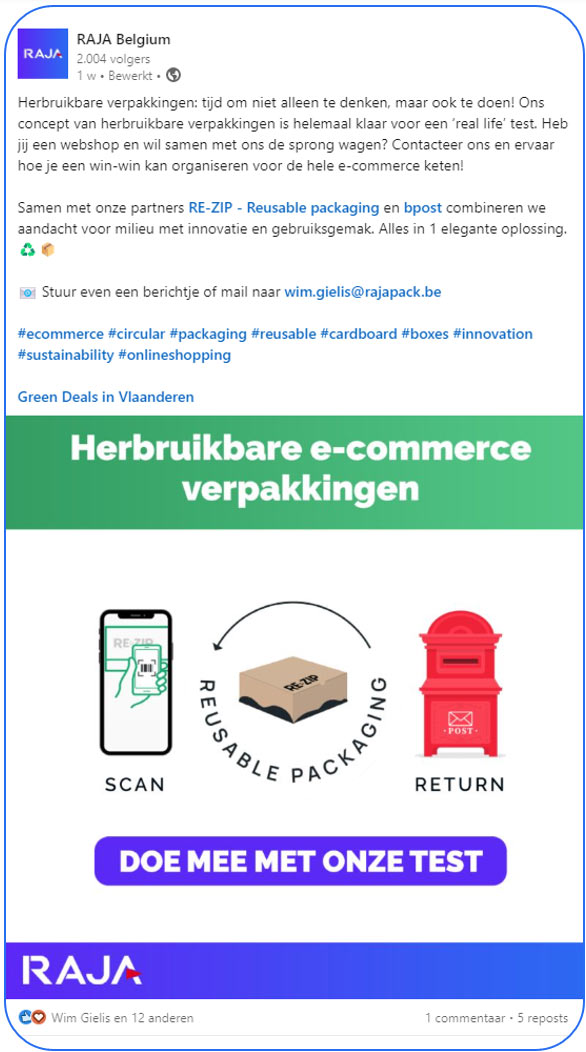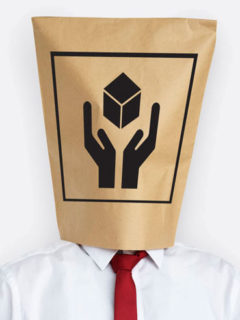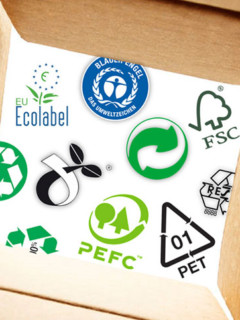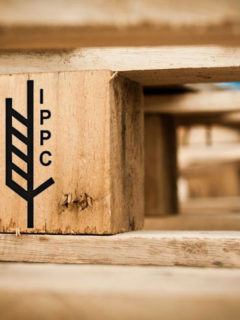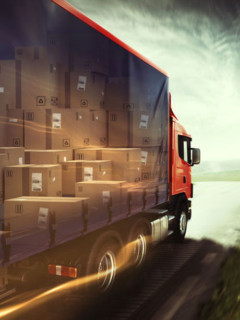Have you heard of the ‘PPWR’? This stands for the Packaging and Packaging Waste Regulation. It is a new legislative proposal from the European Commission, launched in late 2022. This ‘European Packaging Law’ as we call it here will impose new rules on how we package our products. In fact, it is the first time e-commerce packaging has been explicitly mentioned in this context. All the more reason, then, to see what impact this can have on online retailers and how RAJA can already help you with this. Read on and get ready for the future.
1. What does the European Packaging Act entail?
Specifically, the Packaging and Packaging Waste Regulation (PPWR for short) aims to ensure that packaging is more recyclable and reusable by 2030. The focus is on the idea of circularity: today’s packaging should also be able to serve as tomorrow’s packaging. It also considers measures to reduce packaging waste and make packaging materials less complex. For example, by keeping plastic and paper better separated.
Currently, this is only a legislative proposal. This will subsequently have to be transformed into an ordinance. Such a regulation is an equal and binding requirement for all EU member states to create uniform rules for the whole market. Once the PPWR is in force, it will affect all retailers in the e-commerce sector.
Fortunately, the packaging market in Belgium and the Netherlands is already scoring pretty well. A lot of requirements from the legislation have been proactively tackled in recent years. You will find these new future-proof products in RAJA ‘s range anyway – because as a pioneer in the ecological transition, we like to be in the front row. Read on to find out how RAJA can already prepare you for the European Packaging Act now.
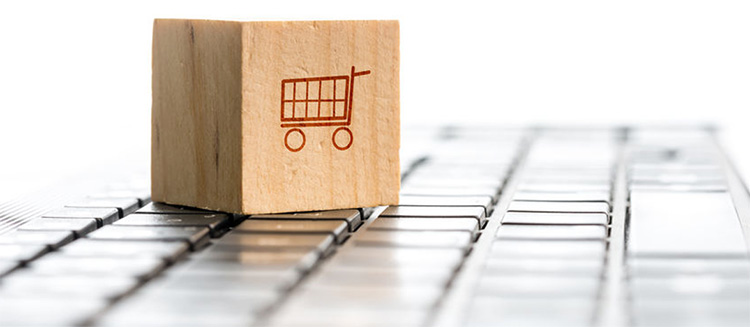
2. How did the European Packaging Act come about?
The European Packaging Act did not come out of the blue. It is the result of years of thoughtful process to make our European economy more sustainable and ecological. Below we list the main milestones for you.
- 2015: the Paris Accords established international agreements to ensure the viability of our planet. The aim is that together we will emit less CO2. The effects of these agreements seep further into our daily lives year after year; just think of the growth of electric car driving or the ban on single use plastics.
- 2019: Following the Paris Accords, the EU launched the Green Deal, a list of initiatives to give member states a more modern and cleaner economy. The aim is to bring net greenhouse gas emissions to zero by 2050. It should also decouple economic growth from the use of external resources. The Green Deal was translated to local and regional authorities, among others. At the Flemish level, RAJA Belgium has been actively participating in this since 2021 for regular consultations with top policymakers.
- 2022: The packaging world and its waste will also be addressed. Within the framework of the Green Deal, the EU launched a proposal for a new legislation in November 2022; the Packaging and Packaging Waste Regulation. It is clear that packaging is necessary in our economy, but the way we deal with it needs to be adapted to the needs of the future. Thanks to RAJA’s initiatives, we can continue to be a reliable partner of all types of businesses in this future.
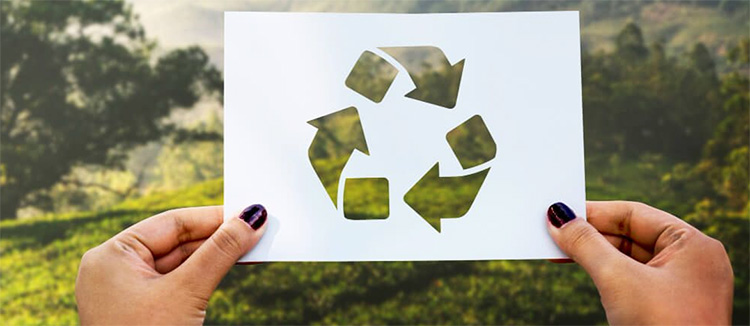
3. RAJA: ready for the European Packaging Act
Packaging or packages that do not comply with the European Packaging Act will not be allowed to be placed on the market in the future. So for e-commerce businesses, this means an extra point to consider. As a website owner, do you suddenly feel the hot breath on your neck? Don’t worry! Below, we introduce you to some RAJA packaging that will allow you to anticipate most of the PPWR’s requirements right now.
► 1. Choose packaging with a circular design
Requirement of the PPWR: The European Packaging Act focuses heavily on the form and composition of a packaging. Circularity plays a big role in this. The bottom line is that you should be able to easily rework today’s packaging into tomorrow’s packaging. Packaging that is easy to sort and recycle within 1 waste stream is preferred. This is also referred to as mono-material packaging. For example, a package composed entirely of paper and cardboard can then be sorted and reprocessed into a new paper product. In this way, we easily(er) complete the raw materials cycle. Paper excels in this respect, as proven by its high recycling rate in Europe (up to 88% and higher in the Benelux countries).
RAJA’s solutions: RAJA currently offers 2,500 products made entirely of paper or cardboard. With this, we enhance the short-term circularity of most packaging. Those mono-material packages didn’t just happen. They are the result of constant innovation and close consultation with our suppliers. For almost every traditional plastic packaging, we can now already offer a paper alternative.
With RAJA’s novelties below, you can put together a package made entirely of an easy-to-sort mono-material: paper!
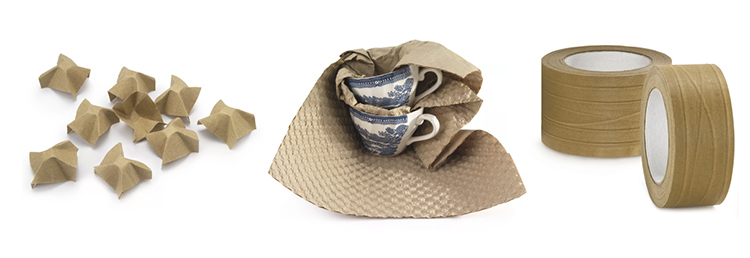
► 2. Opt for recycled materials
Requirement of the PPWR: from 1 January 2030, all packaging must meet new recycling thresholds. Exactly what those thresholds will be depends on the type of packaging. For plastic, for example, this means that every packaging must contain a minimum amount of post-consumer recyclate. This is plastic derived from recycled household waste.
RAJA solutions: when choosing plastic packaging, RAJA is increasingly replacing pure virgin material with recycled material. In total, this already involves some 500 plastic products, from bags and bubble wrap to air cushions. Our aim is to boost demand for this raw material through a high percentage of recycled plastic in our products. Increasing the demand for recycled plastic also increases the incentive to sort plastic really well. This puts us many years ahead of the legal framework, which is now in full development.
Good to know: at RAJA, we consciously choose recycled plastic that is completely transparent. So why? You quite often see bubble wrap or bags to which the manufacturer has added a green dye. That green appearance makes it clear to consumers that the plastic is made entirely (or partially) from recycled material. The downside of this is that the plastic is more difficult to recycle again at a subsequent stage. The green dye ‘pollutes’ the process in the process. So if you are really environmentally aware, always choose recycled plastic packaging that is completely transparent. Below are some examples of popular plastic packaging with a high percentage of recycled material:
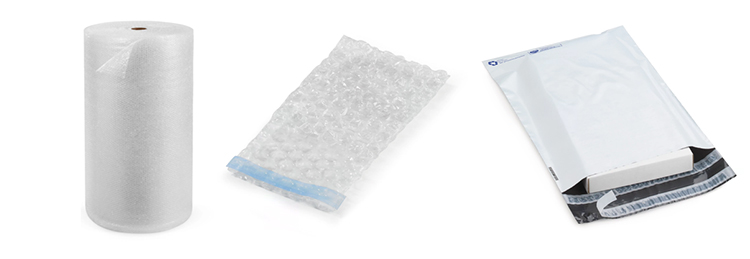
Equally important in this story are our products made of recycled paper and cardboard. Virtually every RAJA cardboard box contains a high percentage of recycled material (70% on average). When selecting new products, this recycling percentage is always an important factor for us. In this way, we already anticipate tomorrow’s requirements today. Moreover, paper packaging materials are easy to sort together after use. By the way, did you know that cardboard can be recycled up to 10 times? Once the boxes are written off, they can easily be processed into toilet paper or newsprint, for example.
► 3. Avoid unnecessary packing space
Requirement of the PPWR: The European Packaging Act requires that the weight and volume of a package must be kept to a minimum – without compromising its safety and functionality. In other words, no packaging should be marketed with unnecessary spaces, such as double walls or double bottoms, to simulate a larger product volume. After the introduction of the bill, a maximum of 40% empty packaging space will be allowed for grouped packaging or e-commerce packages.
RAJA’s solutions: under the motto “every product deserves customised packaging”, it is possible to choose from a range of 1,250 box sizes and 1,300 bag sizes at RAJA. Thus, for every type of product there is a packaging that fits it perfectly. Result? Fewer empty packaging spaces and less excess padding material. RAJA also encourages the use of shipping bags as a substitute for a box. Bags offer excellent protection for fragile products and are much more compact than a box. You therefore save on packaging material as well as transport costs (= the more compact you pack, the less transport volume you take up).
Select the packaging that fits your product perfectly via our:
- Search engine for cartons
- Search engine for bags and sachets
- Or choose a box with variable filling height here
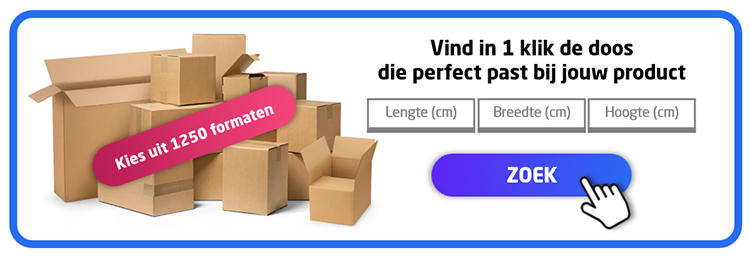
► 4. Targets for reuse and refill of e-commerce packaging
Requirement of the PPWR: Besides recycling,reuse andrefill play an important role in making packaging future-proof. The bill will have clear guidelines on the design of reusable packaging and how often it should be reused. According to the European Packaging Act, 10% of (non-food) e-commerce packaging must be reusable from 2030. By 2040, they even want to increase this percentage to 50% of all packages. This means that, as an industry, we have to look for a new way to deal with packaging….
RAJA’s solutions: to ensure reusability of packaging, we need to be able to adapt return logistics on a large enough scale. The industry is working hard behind the scenes to fill in this blind spot on the map. Among others through the Green Deal in Flanders, RAJA Belgium (and soon the Netherlands) is committing to be one of the first players to put its shoulder to the wheel in this project.
RAJA is actively working on new solutions to bring packaging onto the market that is sufficiently strong, easily pliable and compact to be returned. Preferably, this type of packaging is also renewable and recyclable. Our eye is particularly drawn to innovations using cardboard. You can read why we choose cardboard instead of plastic at the end of our article. We expect to launch the first commercial solutions on the Belgian and Dutch markets in the course of 2023. Can’t wait and would like more info now? Contact us and we will be happy to explain our trajectory to you (0800 224 24 24 or sales@rajapack.nl).
Thanks to all these efforts, we at RAJA can ensure that much less pure raw materials are needed throughout the production and use chain and that the amount of residual waste is significantly reduced. This allows us to do our bit for a circular economy and, together with our customers, reduce the pressure on overall raw material consumption.
Practical tests show that cardboard has more potential than plastic to be developed into a reusable packaging solution. Here's why:
- Cardboard is a strong material, yet easily pliable.
- The production cost of designing a new cardboard packaging is relatively low. Moreover, there is only a short lead time from prototype to finished product.
- Cardboard is often a recycled material in its own right and can be easily recycled afterwards. In case of loss, the cardboard can naturally decompose quickly.
- Both production and know-how can continue to be centralised locally.
- Cardboard is environmentally friendly, renewable and is the best recycling fraction in almost all EU member states.











